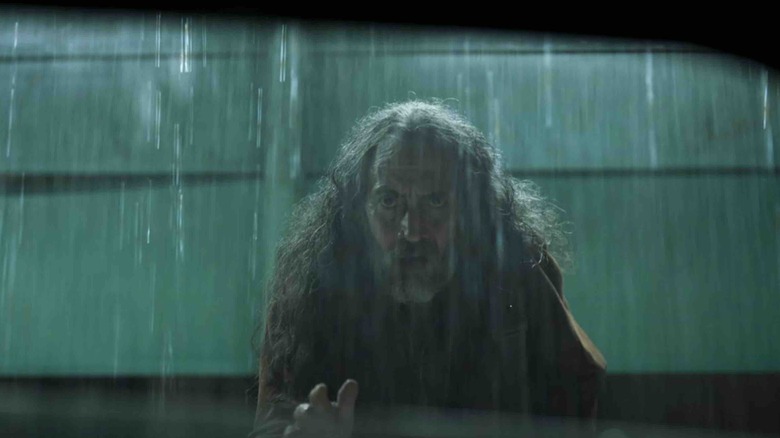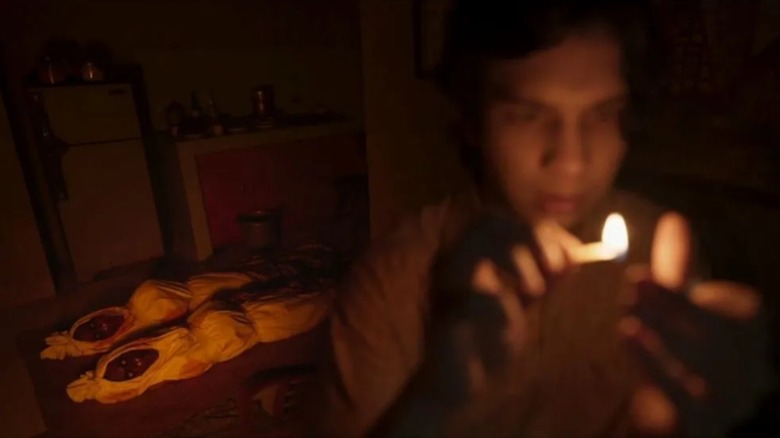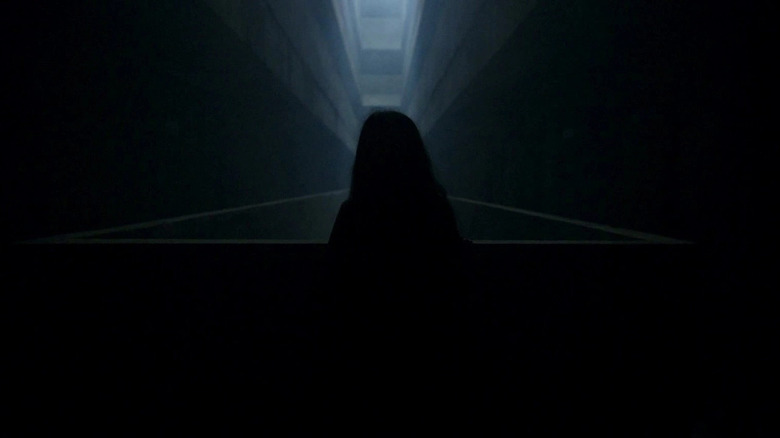Satan's Slaves: Communion Review: Haunted Apartment Complexes Are The New Haunted Houses [Brooklyn Horror Fest]
Joko Anwar blessed horror fans with "Satan's Slaves" in 2018, and now he's back with a compelling sequel that takes haunted house rules and applies them to a busier apartment complex. "Satan's Slaves: Communion" follows "Satan's Slaves" in continuity, hoping to answer questions about cultists with umbrellas, antichrist offspring, and how families move on after satanic rituals. Anwar builds the mythology behind "Satan's Slaves" into something more twisted, which opens as many doors as it closes — not the cleanest evolution in storytelling, but the scares are still tremendous. Whatever's lost in the latter half's exposition dumps is salvaged by Anwar's masterful horror filmmaking sensibilities because while "Satan's Slaves" does reign supreme, that's a loaded comparison to one of the top-ranking horror films of its decade, and since.
It's been several years since Rini (Tara Basro) and her family lost their mother and mute younger sibling Ian (M. Adhiyat). Father Bahri (Bront Palarae) moves them into an outside Jakarta apartment building to escape the dangers of isolation after their unspeakable experience, with sons Toni (Endy Arfian) and Bondi (Nasar Anuz). Unfortunately, evil slithers back into the family's life as a thundering storm looms overhead. Many residents flee the complex before floods turn roads into rivers, but Bahri urges his children to stay put. There's safety in numbers, right?
Anwar translates traumatizing housebound horror imagery to the multi-level apartment landscape, cutting the power early and forcing 1980s-period reactions like underprivileged families battling darkness with matchsticks or candles. "Satan's Slaves: Communion" is a precursor to "Evil Dead: Rise" in this regard, giving audiences a taste of the frights that can be achieved using rickety elevators, stinky garbage chutes, and other commonplace apartment elements. Bahri relocates his loved ones into a higher-populated structure because the natural thought is more people around equals easier times avoiding harm — but Anwar questions our trusting nature of neighbors and turns population comfort against Bahri's clan. Anwar is still the contemporary master of shadowplay next to James Wan and summons emphatic haunted house chills despite urban architecture.
Visceral intensity
"Satan's Slaves: Communion" doesn't shy away from blending ghostly elements already introduced via Rini's veiled undead mother Mawarni in "Satan's Slaves" with more graphic demises more akin to Indonesian gorehound Timo Tjahjanto. Anwar's elevator centerpiece splatters blood all over an innocent childlike slime shot from Nickelodeon cannons, or the brutalized corpses of past victims roam hallways with their mangled parts dangling like limp noodles.
There's a visceral intensity to "Satan's Slaves: Communion" that indulges the icky and macabre, meeting somewhere in the middle between possessed "The Conjuring" ghoulishness and more "Evil Dead" branded squeamish sights. Anwar tickles our psychological side and appeases our hunger for gore, and even throws situational comedy into the mix. Not like "Satan's Slaves: Communion" is a horror comedy — Anwar just lets his teens be mouthy punks with unexpected dialogue pops of humor or inserts meta gags about horror sequels as characters clearly convey their wide-eyed PTSD when someone even suggests reliving the original film's sinister supernatural events.
As the narrative unfolds, some subplots work better than others. Anwar recalls "Pulp Fiction" by giving Bahri a briefcase that no one should ever unlock and introduces a Jakartan sniper on the loose who's killed some thousand people with tattoos. Rini's family was already marked by maniacs, so recurring threats are understood — but Anwar reveals Mawarni was only the beginning. "Satan's Slaves: Communion" does suffer a sequelitis symptom when storytelling tries to build upon existing mythology into something grander, where ideas can become cumbersome when both providing answers and instigating new twists. Especially towards the end, "Satan's Slaves: Communion" starts hurling explanations like playing catch-up and overburdening the ease of haunted excitement that otherwise is prevalent. Anwar leaves the door open for another possible entry, but forward-thinking hinders more concise storytelling that could have been otherwise wrapped cleaner come this second film's close.
Primetime scare executions
Although, the horror fan within spots too much value in the spectral chases throughout "Satan's Slaves: Communion." Rini, Toni, and Bondi spend time exploring the ten-plus floored estate on their separate quests, which opens the door for primetime scare executions. Anwar draws inspiration (intentional or not) everywhere from "The Texas Chain Saw Massacre" to J-Horror to his Indonesian horror buddies, showing a robust understanding of horror's infinite flavor combinations.
Cinematographer Ical Tanjung intentionally refuses to expose ghastly spirits or weeping women too early, concealing these fabulously fearful jolts that lead our nerves to their demise. Toni's inability to keep matches lit allows for objects to creepily shift position between illumination — one of countless instances where Anwar proves that notable genre tropes can still raise hairs when effectively implemented. There's a ghost town feel that keeps tension rolled tight, which allows Anwar to execute lonesome wanderers and apply dread like a balm that soothes horror fans with constant discomfort (we're watching horror to wince and squirm).
"Satan's Slaves: Communion" fulfills all the expectancies and obligations that come along with another mainstream Joko Anwar experience. Well, "mainstream" for Indonesia, since "Satan's Slaves: Communion" was the first Indonesian movie to release in large screen IMAX format (only a Shudder release stateside). No, it's not as good as the immaculately morose and magnificently devastating "Satan's Slaves" — but few titles are. "Satan's Slaves: Communion" delivers another artfully accomplished and wickedly malevolent slice of Indonesian horror that returns to formula basics without sacrificing Anwar's trademarks. Maybe a bit too ambitious with its storytelling. But still righteously right-on in terms of razor-toothed horror execution.
/Film Rating: 8 out of 10


